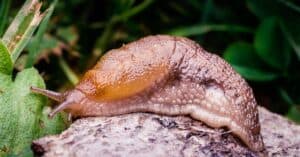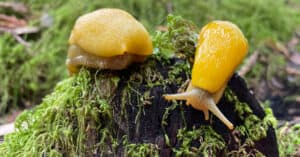Slugs are like snails but they lack the protective shell that most snails have. They’re gastropods that produce a slippery slime that they excrete to slide on to get around. Slugs have two antennae coming out of their heads with eyes on the end to help them see where they are going and where their next meal might be.
But what do slugs eat? Read on to find out all about slugs and what they eat!
What do Slugs Look Like?
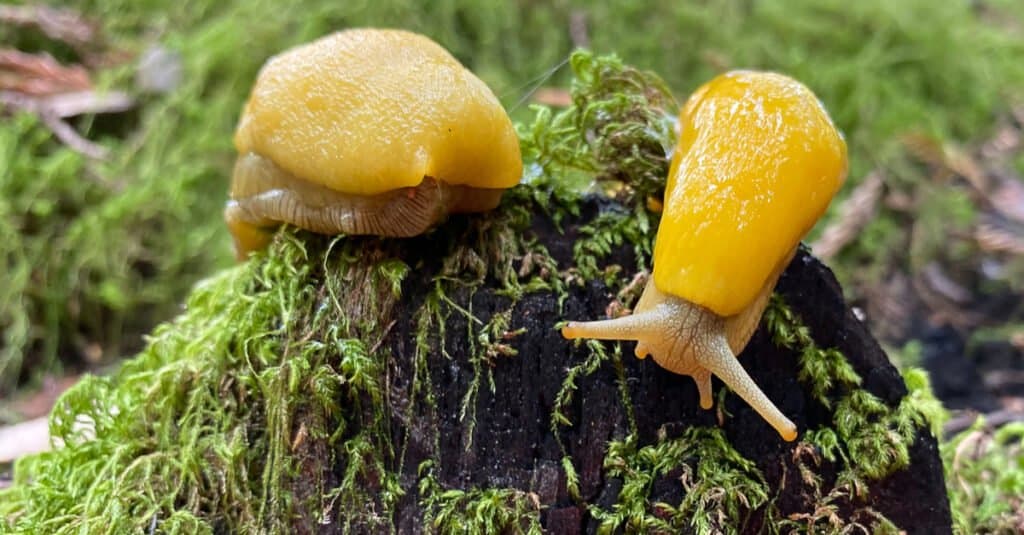
Slugs commonly are earth-toned to match their surroundings.
©Meyta/Shutterstock.com
Slugs have an elliptical body, thinner at the head and tail. They can be a variety of colors depending on the species but most are earth colors of brown, tan, green, and grey. Some, like the banana slug, are bright yellow and others, like the leopard slug, are spotted or striped. The skin of the slug is covered in slimy mucus that serves as a protective cover and is used to assist it in getting around. Under the slug is one muscular “foot” that contracts and releases to move around. Their heads have two antennae with eyes as well as two sensory tentacles that are used for feeling and tasting.
How Big are Slugs?
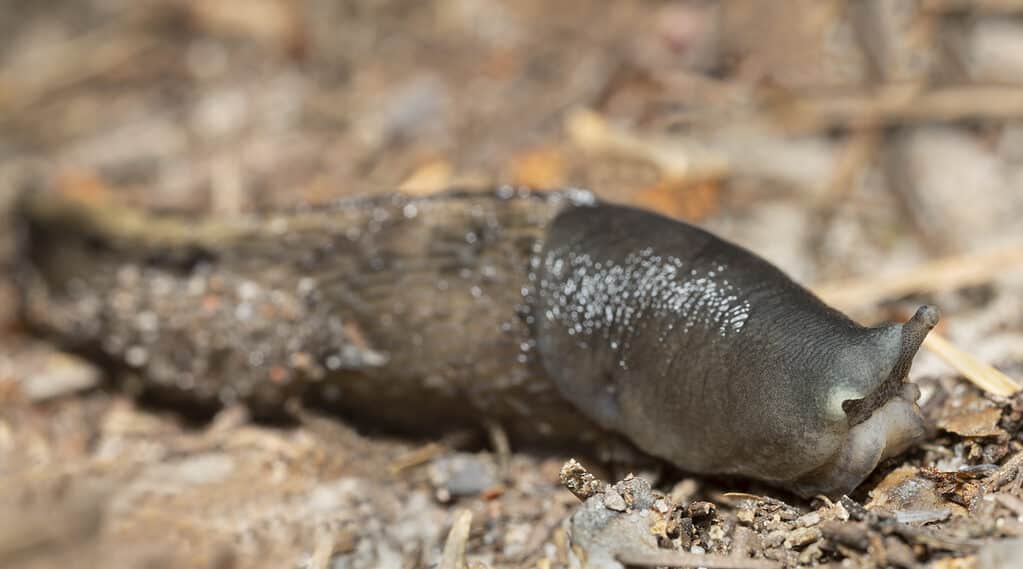
Limax cinereoniger is the largest slug.
©iStock.com/Henrik_L
Slugs vary in size from ½ inch all the way up to almost 10 inches. One of the smallest land slugs is the Pygmy slug Kootenaia burkei which is less than 15 mm (1.5 cm); about the size of your fingernail. One of the biggest land slugs is the ash-black slug (Limax cinereoniger) which can grow up to a foot long in some places!
What do Slugs Eat?
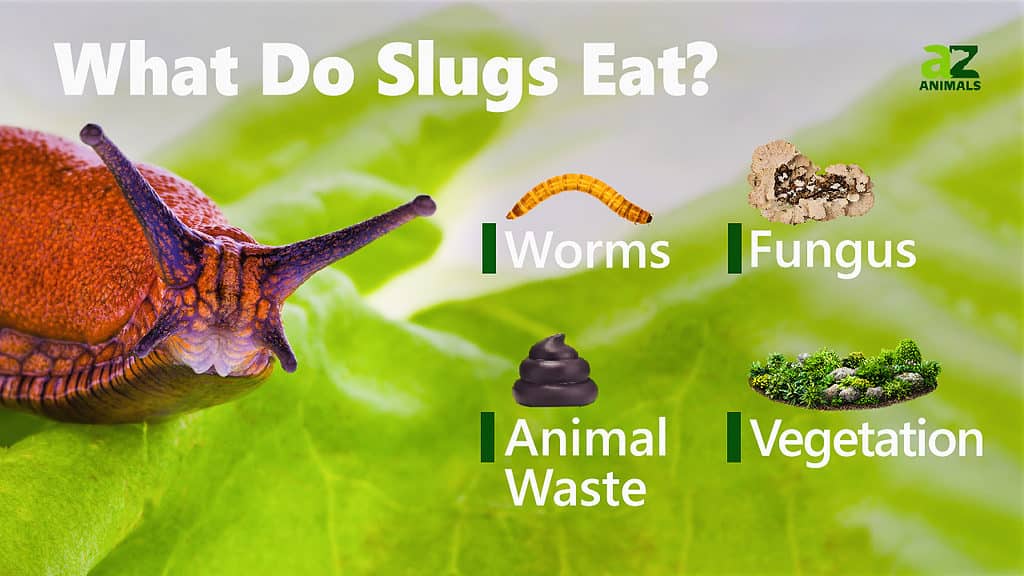
Slugs eat plant matter, leaves, mushrooms, fruit, and carrion. Slugs are omnivores eating both plant and animals. They really are generalists meaning they will eat a variety of food, with some species more prone to eat specific kinds of food. For example, some slug species are more frugivores and eat mostly fruits like apples, strawberries, and grapes while others will eat mostly mushrooms. There are some slugs that feed on fungi or slime molds. Flowers, like lilies, daisies and petunia can be eaten by slugs and so are certain vegetables like cabbage, lettuce, peas, and carrots.
How do Slugs Eat?
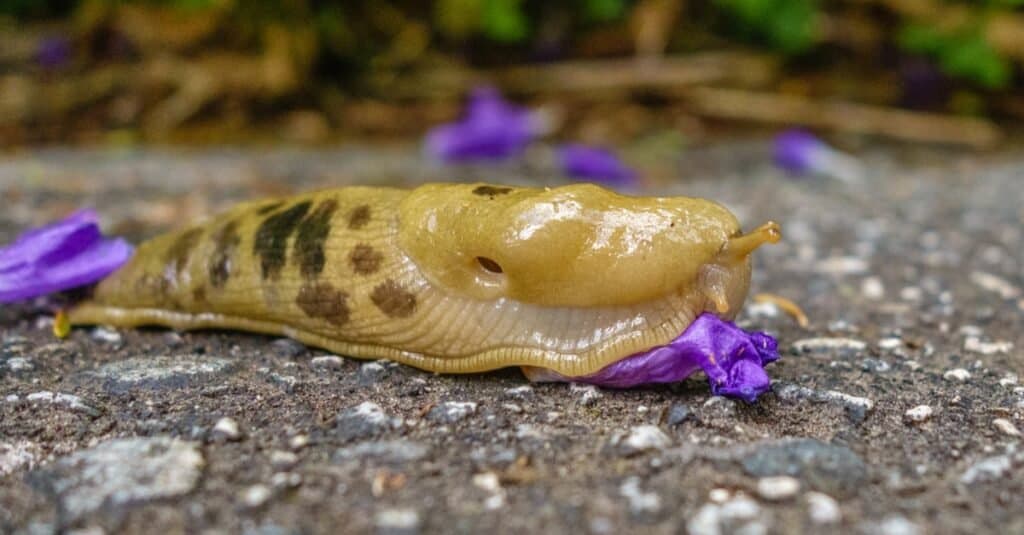
A Pacific Banana Slug eating bright purple flower petals. Slugs don’t have teeth or tongues. They have a special organ called a radula that has thousands of tiny protrusions that help them grind up their food.
©Heidi Besen/Shutterstock.com
Slugs eat by using a mouth-like opening below their lower tentacles. Do slugs have teeth? Kind of! They have a radula, which is a tongue-like organ that is covered in denticles. There are rows and rows of thousands of tiny tooth-like denticles that grab the food of the slug and help move it down to their stomach.
How much do Slugs Eat?
Slugs can eat up to twice their weight (or more) depending on the availability of food. A typical slug weighs around 300 milligrams so it doesn’t take a ton of plant matter to sustain these animals but their daily intake needs to be averaged over time.
What Eats Slugs?
Predators of slugs include beetles, snakes, ducks, toads, starlings (actually a variety of birds), and turtles. The slug’s main line of defense is their slippery slime. The mucus they produce has a numbing effect to creatures that try to eat it. If a raccoon initially tries to eat a slug it may be hit with an unusually numb tongue making the animal think twice before consuming it.
Are Slugs Poisonous?
No. Slugs are not poisonous. You can pick up or handle a slug and the mucus would not harm you. If for some reason you ingested one they are not poisonous but can carry diseases and parasites. In contrast, the poison dart frog has toxins in their skin which can cause irritation to your skin if you were to touch one. Animals that eat poison dart frogs do typically die from ingesting the poisonous frogs. Animals that eat slugs do not die from eating them.
What are the Most Common Slugs?
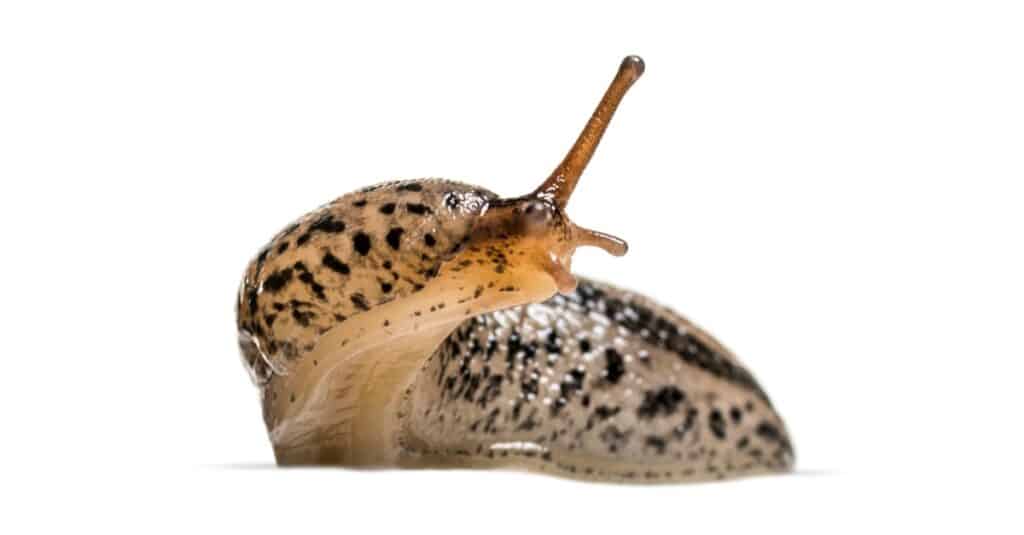
Limax maximus, literally, ‘biggest slug’, known by the common names great grey slug and leopard slug
©Eric Isselee/Shutterstock.com
Grey garden slug: Sometimes called a grey field slug, these slugs are found in Europe, North America, and South America. As their name suggests they are frequently found in gardens and/or agriculture fields. They have grayish bodies with some having darker markings and are around 4-6 cm. Grey garden slugs eat leaves, fruit, and seeds.
Leopard slug: Leopard slugs get their name from the leopard-like spots on their back. These slugs are some of the biggest ranging from 6-8 inches long. They eat leaves, bark, decaying plant matter, other slugs and fungi.
Dusky slug: These slugs have rows of pale or cream bumps along their backs. Their yellowish-brown color comes from their slime which can stain your hands if you handle them. They are bit smaller, around 2-2 ½ inches long. Dusky slugs eat plant matter, mushrooms, animal waste and fruit.
Banana slug: Banana slugs get their name from their bright yellow banana-looking coloration. Some are browner in color but the bright yellow ones are easy to recognize. They are the second largest slug with some reaching 9.8 inches in length! Banana slugs eat dead leaves, animal waste, mushrooms, and moss.
Worm slug: These slugs have long skinny bodies resembling worms. They are only about 1-2 inches long but thicker than worms and have the same tentacles as other slugs. Worm slugs eat earthworm waste, carrion, and decaying plant matter.
Are Slugs Good for a Garden or are they Pests?
Slugs are not good for your garden. They are usually considered pests. Because they eat leaves and seedlings they can destroy some of your plants and flowers. They may eat holes in your bulbs and eat plant roots, so yes, they are known as pests in the garden.
Some slugs are also invasive species, like the leopard slug in North America. This slug is a problem in Hawaii because it eats plant seedlings and it also can spread the dangerous Rat Lungworm infection. In the Northwestern states it competes for resources with the native banana slugs.
What are Slugs Good for?
Slugs do have an important role in their habitats. They are good for dispersing seeds and spores and their slimy trail of mucus is actually good for the helping in the decomposition process. Slugs may slide through their life eating most of what they come across, but they also take care of some of the old decaying plant matter and animal matter and convert it to fertilizer-like waste. They are certainly not the most adorable animals, but they do have an important role in their ecosystems.
Up Next
- 10 Incredible Slug Facts
- Is a Snail without a Shell just a Slug?
- Slug vs Snail: The 3 Key Differences Explained
The photo featured at the top of this post is © Lisa-S/Shutterstock.com
Thank you for reading! Have some feedback for us? Contact the AZ Animals editorial team.



